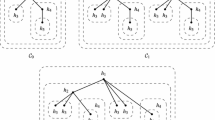Abstract
We present a transformation of membrane systems, possibly with promoter/inhibitor rules, priority relations, and membrane dissolution, into formulas of the chemical calculus such that terminating computations of membranes correspond to terminating reduction sequences of formulas and vice versa. In the end, the same result can be extracted from the underlying computation of the membrane system as from the reduction sequence of the chemical term.
Similar content being viewed by others
References
Agrigoroaiei O, Ciobanu G (2011) Flattening the transition P systems with dissolution. In: Gheorghe M, Hinze T, Păun G, Rozenberg G, Salomaa A (eds) Membrane Computing, 11th International Conference, CMC 2010, Jena, Germany, 2010. Revised Selected Papers. Volume 6501 of Lecture Notes in Computer Science. Springer, Berlin, pp 53–64
Andrei O, Ciobanu G, Lucanu D (2006) Structural operational semantics of P systems. In: Freund R, Păun G, Rozenberg G, Salomaa A (eds) Membrane Computing, 6th International Workshop, WMC 2005, Vienna, Austria. Revised Selected and Invited Papers. Volume 3850 of Lecture Notes in Computer Science. Springer, Berlin, pp 32–49
Andrei O, Ciobanu G, Lucanu D (2007) A rewriting logic framework for operational semantics of membrane systems. Theor Comput Sci 373:163–181
Banâtre JP, Fradet P, Radenac Y (2005) Principles of chemical programming. Electron Notes Theor Comput Sci 124(1):133–147
Banâtre JP, Fradet P, Radenac Y (2006) Generalized multisets for chemical programming. Math Struct Comput Sci 16:557–580
Banâtre JP, Le Métayer D (1986) A new computational model and its discipline of programming. Technical Report RR0566, INRIA
Battyányi P, Vaszil Gy (2014) Describing membrane computations with a chemical calculus. Fundam Inform 134:39–50
Bottoni P, Martín-Vide C, Păun G, Rozenberg G (2002) Membrane systems with promoters/inhibitors. Acta Inform 38:695–720
Ionescu M, Păun G, Yokomori T (2006) Spiking neural P systems. Fundam Inform 71:279–308
Martín-Vide C, Păun G, Pazos J, Rodríguez-Patón A (2003) Tissue P Systems. Theor Comput Sci 296:295–326
Mitchell JC (1996) Foundations of Programming Languages. MIT Press, Cambridge
Păun G (2000) Computing with membranes. J Comput Syst Sci 61(1):108–143
Păun G (2002) Membrane Computing. An Introduction. Springer, Berlin
Păun G, Rozenberg G, Salomaa A (eds) (2010) The Oxford Handbook of Membrane Computing. Oxford University Press, Oxford
Acknowledgments
The work of the authors from Iasi was supported by the Romanian National Authority for Scientific Research, project number PN-II-ID-PCE-2011-3-0919.
Author information
Authors and Affiliations
Corresponding author
Rights and permissions
About this article
Cite this article
Aman, B., Battyányi, P., Ciobanu, G. et al. Simulating P systems with membrane dissolution in a chemical calculus. Nat Comput 15, 521–532 (2016). https://doi.org/10.1007/s11047-016-9570-5
Published:
Issue Date:
DOI: https://doi.org/10.1007/s11047-016-9570-5




